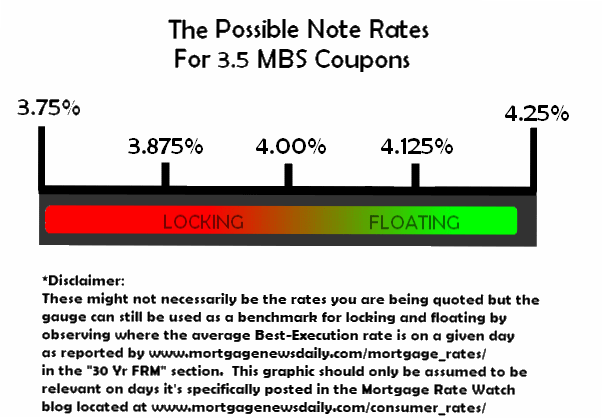So have you heard the one about the markets that were highly susceptible to European headlines? There's no punch line. It's not a joke and there's really nothing funny about it.
Case in point, consider the fact that Treasury yields are significantly lower today, having fallen from around 2.07 to 1.96, but Mortgage Rates have barely budged! Reason being, the market-based panic created by concerns about the debt situation in the EU primarily benefits Treasuries. MBS (the bonds that most directly affect mortgage rates) don't have the same safe haven appeal and tend to underperform Treasuries at times like this. Thus, fairly flat mortgage rates while Treasuries rally.
Granted, we can (and often do, over on the MBS Commentary Blog) go into much more detail on this, but that's the gist. And on an even pithier note, the bottom line is that Best-Execution rates are unchanged vs yesterday. Some lenders are a touch higher or lower in terms of closing costs, but only in rare cases would you be looking at a change in a rate quote today.
Today's BEST-EXECUTION Rates
- 30YR FIXED - Centered on 4.0%, getting close to 4.125%
- FHA/VA - 3.75- 3.875%
- 15 YEAR FIXED - 3.375%-3.5%
- 5 YEAR ARMS - low 3% range, huge variations from lender to lender.
Ongoing Guidance (keeping this one relatively static until rates move): Rate offerings from lenders over the past month have been like a temperamental pitching machine in a batting cage-generally getting the ball across the plate, but with no really juicy pitches. But recently, we've seen some more consistently good pitches (best-ex around 4.0% instead of 4.25%). Sure... you've seen better, but not by much (3.875% and RARELY 3.75%). How many more will you count on before calling it a day? Personally, I'd like to end my batting cage session with a nice hit. The more "pitches" you wait for with rates already at a 4.0%, the greater the risk that the next pitch will be a curveball. To drop the metaphor, although rates this low CAN go slightly lower, the improvements are fairly minimal compared to how much higher they could go. Still, if you're not in any particular need to refinance and are operating on a longer-term perspective, we continue to feel good about that "wall" at a 4.25% best-execution level as a good stop-loss point for inclined floaters. Ask us to explain more about that if it doesn't make sense.





